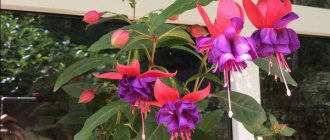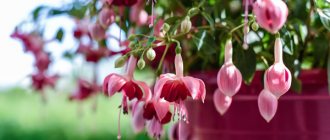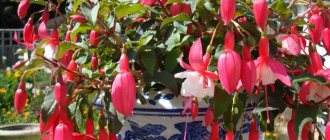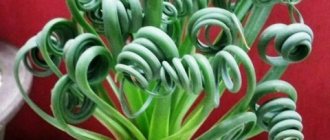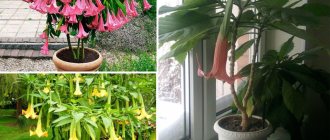Fuchsia is a plant from the genus Willowherb and is a perennial. The flower got its name from the name of Leonart Fuchs, a famous botanist. Widely distributed in Central and South America.
Indoor fuchsia has long been loved by residents almost all over the world. Fuchsia is a bright, very elegant interior decoration. The unusual shape of flowers and fantastic colors will create a harmonious accent in a room of any style. In honor of one of the most popular shades of fuchsia flowers, designers and artists even came up with the same name for the color - fuchsia.
Fuchsia is not only a beautiful decorative element, but also an easy-to-care plant. However, it is still necessary to get to know it better in order to avoid common mistakes and improve health and prolong the life of the flower.
Forms and varieties
There are about 100 types of fuchsia in total. For more than 200 years, fuchsia flowers have been grown in a variety of different hybrid varieties and forms. Unpretentious, persistent species of this plant bloom at different times of the year, so with proper selection, you can create an ever-blooming garden in your home.
Bush fuchsias upright
One of the most popular and widespread forms of fuchsias. Characterized by high, about 35-90 cm, frequently spaced branches. The cuttings are long, with oblong oval leaves with veins arranged in opposite order. The flowers resemble bright lanterns, arranged singly or collected in sparse racemes, which are located in the axils of the leaves.
Bush fuchsias are used to create trunks: the side shoots break off, so the flower grows only upward. The result is an expressive and spectacular floral column. If the plant is not trimmed on the sides, you will end up with a spherical bush with flowers all over the area - the natural appearance of this form.
The bush flower is suitable for growing both indoors and in gardens.
Ampelous fuchsias
Fuchsia ampelous has long, freely flowing, gracefully flexible stems. Thanks to this stem shape, the flower looks elegant in hanging pots that decorate verandas, gazebos, and loggias. The flowers of the plant are medium or very large in size. Their colors are very diverse: many shades from white and milky pink to deep purple. There are also two-color, terry and semi-double.
Often several cuttings are planted in one container - in this case the flowering becomes more voluminous and spreading.
Sometimes ampelous forms are grafted onto a standard tree, resulting in tall columnar trees with a weeping crown.
This form of fuchsia does not tolerate aggressive direct sunlight and does not tolerate drafts.
Semi-ampel fuchsias
Initially, semi-ampelic varieties are not much different from ordinary bush forms with erect shoots. The flowers of this fuchsia are large and voluminous; over time, they bend the stems towards the ground with their weight. As a result, during flowering the plant takes on a shape close to an ampelous one.
The flowers of semi-ampeled fuchsias are so heavy that they can break off shoots. To prevent this from happening, it is best to tie them to supports.
Forming and pruning shoots can significantly change the appearance of a flower, adjusting it to the desired shape that suits the overall style.
Bush varieties
Avid flower lovers, despite their established favorites, are attracted to new varieties. Both beginners and experienced plant growers should study fuchsia varieties before planting: knowledge of their characteristics will allow them to grow a high-quality flowering, healthy plant.
Rohees New Millennium
One of the most fascinating fuchsia varieties. The bush is compact in size, its height is only about 40 cm. The shoots are strong, woody, making the flower suitable for forming into a tree. The leaves are elongated oval in shape, with a pointed tip. Rich light green color, smooth, with a pronounced skeleton. The flowers are medium and large, directed downwards. The variety is presented in one contrasting color combination: the sepals are light pink, the skirt is the color of overripe cherries. This color combination makes fuchsia look exotic.
Millennials complain about the problem of “reluctant” sluggish flowering out of season. In most cases, the problem can be resolved with timely feeding: the variety is sensitive to the lack of nutrients in the soil.
Andromeda
Fuchsia bush Andromeda is a tall plant, its height can reach up to 90 cm. The shoots quickly become woody, which makes it possible to grow the bush in the form of a trunk, but it is also incredibly beautiful growing in any order. Growth is fast.
Types of fuchsia with photos
Fuchsia fulgens / Fuchsia brilliant
A shrub that can grow up to two meters, which came to us from Mexico. The branches are covered with leaves (about 12 cm wide, up to 20 cm long) oval in shape, with jagged edges. It blooms for a long period (from late spring to late September). The flowers are arranged in clusters and look like ten-centimeter tubes narrowed towards the bottom. A pestle sticks out from each tube, equal in length to the petals themselves. The flowers themselves are red. After flowering ends, edible berries ripen on the shiny fuchsia.
Fuchsia boliviana / Bolivian Fuchsia
A small shrub (up to a meter in height) from Bolivia. The leaves are oval-shaped with a pointed tip, no more than 15 cm long and about 6 cm wide. It blooms mainly in spring. The flowers are burgundy in color and appear in lush clusters of one centimeter flowers.
Fuchsia magellanica / Fuchsia Magellanica
This type of fuchsia can also be found under the names “conical fuchsia” or “variegated fuchsia”.
This is a fairly large shrub, more like a tree, which can reach a height of up to 5 meters. Each part of this fuchsia has its own unique characteristics. The color of the bark of the branches is purple, while the branches are covered with fluff. The voluminous leaves (up to 50 cm in length) are collected in bunches of three leaves. The leaves themselves have serrated edges, are bright green in color, with purple veins. Buds form on the branches, which bloom in bouquets of 4 large tubular flowers. The flowers have a heterogeneous color - the tube itself is pink, and the petals coming from it are purple. This fuchsia blooms from late spring to early autumn.
Fuchsia corymbiflora / Corymbose fuchsia
Also a very large shrub (up to 5 meters), which grows in the mountainous regions of South America. It gained popularity at home due to its variegated color. The foliage reaches a width of 7 cm, a length of about 17. The leaves themselves are oval in shape, and instead of serrations there is fluff along the edge. In the center of the leaf there is a bright red vein. Blooms in the summer months. The flower tubes are bright red and turn into bright purple petals.
Ampel varieties
The ampelous shape of fuchsia creates a festive mood. Varieties of these flowers take root well on terraces and balconies in hanging flowerpots. Plants in pots that decorate arches and bridges look very beautiful.
Golden Marinka
The flower has weak branches and blooms profusely and luxuriantly. Marinka's shoots are small, only up to 30 cm. Cuttings take a long time to take root. The shoots are strong and strong and do not break off, however, pinching the apical buds is necessary to preserve the aesthetic appearance.
The leaves are medium-sized, variegated, from light yellow-green to deep yellow. Oblong and smooth, the tip is pointed. The flowers are simple, semi-double are less common. The size is medium, the skirt and sepals are bright red.
It must be taken into account that the variety is susceptible to excess moisture.
Isisl (Icicle)
One of the most delicate fuchsia varieties. The bush is vigorous. The shoots are reddish in color and do not become very woody. Flowering is abundant and lush.
The leaves are rich green, the veins are red-brown. Medium size, smooth, oval in shape with a pointed tip. The flowers are very large, with long light milky sepals and a voluminous pale pink skirt.
The variety does not tolerate sunlight and gets burned quickly. Cuttings take root with difficulty, so it is quite rare to see such fuchsia.
First Love
Also a rare variety. Characteristic features: rapid growth and branching, graceful shoots, elongated buds.
The leaves are dense, elongated oval in shape, medium green in color. The sepals are snow-white, slightly powdered with a light pinkish haze. The skirt is fluffy, a delicate pink shade, with a pink blush at the base. The flowers are large.
Cuttings take root slowly and with difficulty. Like most fuchsias with light flowers, they quickly get burned.
Semi-ampel varieties
Fuchsias are interesting in shape and change their appearance. Experimenting with the formation of a bush will create a unique charm and zest in the room or on the site.
Fairy
A medium-sized bush with delicate lush flowers of incredible beauty. Shoots reach sizes up to 35 cm.
The leaves are quite large, rounded, moderately green in color. They have brown veins. The flowers are voluminous. The sepals are a cool milky pink hue, the petals are elongated, terry, raised and curled. The skirt is lilac-violet, with a blue tint, silky.
A relatively unpretentious variety to care for, it grows and develops quickly. The shoots become woody, which makes it possible to form a trunk.
Golden Monique
A weakly branching bush. Blooms abundantly, flowers are small. The shoots are woody and can be grown in the form of a small tree.
The leaves are decorative and look beautiful in the dormant phase. They have a golden-green hue, decorated with reddish veins. The flowers are double, the sepals are deep reddish-pink. The skirt is bright pink.
The unpretentious fuchsia of this variety winters well and loves good lighting. With a lack of sun, the leaves turn green and lose their yellow tint. Cuttings quickly and easily produce roots.
La Fiesta
Medium-sized variety, shoots reach a length of up to 40 cm. The shoots are strong, branching. The buds are elongated, flowering is abundant.
The leaves are light to medium green with purple veins. The flowers are large, the sepals are oblong, white with pale green tips. The skirt is bright red, with a raspberry tint, and decorated with pink strokes.
Cuttings root slowly.
Fuchsia growing and care at home
Fuchsia is not a very demanding plant; even a beginner can cope with its cultivation. However, it is worth immediately learning how to care for fuchsia correctly so that the flower does not die, and the flowering is lush and abundant and pleasing to the eye. Contemplating the results of your own labors is the best reward.
Selection of location and soil
The basis for the health of any plant is proper planting in suitable soil. It is optimal when the soil for fuchsia consists of a mixture of three parts leaf soil, two parts peat and one part sand. It is necessary to strictly observe the proportions, then the soil will be fertile and will help the flower gain strength before the upcoming flowering.
It should be taken into account that different varieties of fuchsia prefer different light levels and temperatures. It is best to choose a place without direct sun, strong drafts and hot air flows from heating radiators.
Landing
A young purchased or borrowed flower should be planted immediately in a new soil mixture in a pot of a suitable size. To do this, drainage and soil are poured into the container, the root is hidden in the recess and soil is filled in again. After transplantation, you do not need to feed the plant, but it needs abundant watering and spraying. It is necessary to make a drainage layer in the soil, because most fuchsias do not tolerate stagnant moisture. The pot is placed in a well-lit place without direct sunlight.
Fuchsia ampelous: features of cultivation and care at home
As a potted plant, the flower has become widespread in Europe since the late 18th century. The flowering bush served as a source of pride for wealthy townspeople. According to the description of contemporaries, the palace of Marie Antoinette of France resembled a greenhouse due to the number of fuchsias.
Fuchsia in a flowerpot
Modern hybrid varieties of fuchsia, thanks to the plasticity of the branches and the variety of colors, are universal. Depending on the varietal characteristics, they can be used for landscaping at home, office, and garden.
Important ! The pot with the plant cannot be moved or even rotated during the flowering period, otherwise the flowers and buds will simply fall off.
The flower needs nutritious, but light soil. To do this, you can add to the usual one intended for flowering plants:
- perlite;
- vermiculite;
- coco soil (coconut substrate).
Fuchsia loves good lighting, but gets burns on the leaves when exposed to direct sunlight. It is better to place it near windows that are lit before lunch or in the late afternoon. If it is not possible to provide the plant with natural light, you can use fluorescent lamps for illumination. Lack of light causes the shoots to stretch, and the plant may not bloom.
In summer, fuchsia feels good at temperatures no higher than 20-23 °C. The plant does not tolerate heat well, so with the onset of a warm period it is recommended to take it outside.
Fuchsia blooms well in warm periods on the balcony, the main thing is to provide shading during the midday hours. Blown by the wind, it tolerates high temperatures better. The flower can remain outside until frost. Conditions for good wintering are temperatures from 3 to 100 °C and, if possible, lighting. Then the plant will stop growing and will not extend shoots. Fuchsia that is properly preserved in winter will bloom earlier.
Important ! Fuchsias develop quickly and bloom profusely, so they need to replenish the necessary microelements. They need to be fed regularly, every week, with fertilizers containing a predominance of potassium and phosphorus. Fertilizing should be done after pinching is completed.
The plant is moisture-loving; frequent spraying and washing are necessary, as is regular watering. In summer, to humidify the air, additionally place a container of water nearby. If there is insufficient moisture, the plant may drop flowers. Spray and water the plant on the balcony or loggia in the evening or early in the morning.
In the warm season, the plant is watered abundantly; it is especially important to monitor the humidity during the budding period.
With the onset of winter, watering is gradually reduced to a minimum, the main thing is to prevent drying out.
Water for irrigation and spraying should be either settled or rainwater, always at room temperature.
Important ! The roots should not be allowed to become waterlogged due to waterlogging of the soil. Yellowed foliage and a brown coating on the soil may indicate a wet root system.
Pests and diseases
Fuchsia is rarely attacked by pests; most problems arise due to poor care. Fortunately, almost all unpleasant situations can be quickly corrected.
The most common plant pests:
- spider mite, when it appears, the flower often reacts by dropping leaves;
- whitefly, which can be detected in time by noticing red spots on the leaves.
The fight against insects is successfully completed with the use of insecticides.
Frequent problems:
- quickly ending flowering caused by insufficiently cool conditions during wintering, lack of lighting during the ripening period of buds or excess nitrogen;
- loss of leaves due to improper watering, low or excessive lighting, low air humidity, high temperature;
- changes and pallor of the leaves indicate poor soil or excessive watering in winter;
- buds usually fall off as a result of drafts or sudden changes in light during their growing season.
Analyze the conditions under which the flower is kept and, if possible, eliminate the cause.
Problems, diseases, pests and methods of treating fuchsia
Although fuchsia is not a very picky plant, its beauty can be influenced by various factors. The most common “whims” of this plant are as follows.
Fuchsia finished blooming very quickly
This phenomenon is promoted by improper care during the various phases of the plant’s life.
In most cases this is:
- abundant watering from December to February and temperatures above 10 degrees;
- lack of sufficient lighting during the flowering period;
- poor watering and lack of regular fertilizing during the growing season;
- The room is not ventilated and the air stagnates.
Fuchsia bush sheds leaves
In winter, leaf fall may be due to the fact that the fuchsia is in a strongly lit room and the temperature exceeds 10 degrees Celsius.
In summer, during the growing season, foliage may fall due to lack of watering, dry air and very high temperatures.
Fuchsia sheds unopened buds
This problem is usually caused by insufficient lighting, dry air, insufficient watering, temperatures exceeding 25 degrees Celsius, or being in a draft.
Also, during the flowering period, fuchsia gets rid of its buds if it is disturbed. Therefore, you should not turn the fuchsia pot or move it to another place when it has entered the active phase.
Fuchsia leaves are covered in spots
Spotting is caused by two reasons:
- abundant watering in winter;
- and burns from direct sunlight in summer.
If these factors are excluded, the bush will soon recover.
Pests
Fuchsia is most often attacked by whiteflies and spider mites. In such a situation, you should cut off the damaged leaves and spray the plant with repellents.
Caring for fuchsia in autumn and winter
Caring for fuchsia at home during the dormant period is not difficult, the main thing is to correctly arrange the conditions of detention. If you follow the wintering rules, the plant will delight you with beautiful flowering and healthy growth.
In autumn, the flower begins to prepare for the resting phase; in winter, it regains its strength. If you don’t help it by creating favorable conditions, then you shouldn’t expect good flowering from it in the spring. Remember that from the beginning of autumn, fertilizing stops and the intervals between watering increase. Withered leaves are removed, overgrown shoots are pruned. If pests are noticed, treatment is required.
Wintering in an apartment
Fuchsia can winter in an apartment. The ideal place for hibernation is an insulated glazed loggia or balcony, where the temperature ranges from 10 to 15 degrees. The pot should be placed in a place with diffused light, without direct sunlight. The container itself can be insulated with polystyrene foam or foam rubber or padding polyethylene film. The top of the soil is sprinkled with sawdust. The lower the temperature, the less frequent the watering. Many varieties of this plant can withstand frosts down to -10 degrees, but still you should not allow the soil to freeze to such an extent.
A bush that has overwintered at a normal room temperature of 18-24 degrees may bloom poorly or not bloom at all. If there is no other maintenance option, the frequency of watering is not reduced. Additionally, you can set the micro-ventilation mode on the window; this will not create strong drafts, and the temperature will drop slightly.
Wintering in the basement
During wintering, you can keep fuchsia in the basement, cellar or even garage. In the resting phase, it does not need bright light; if possible, you can turn on the phytolamp indoors for a short time at a great distance. It is necessary to take into account that if the room freezes, then there is a high probability that the plant will also freeze. You shouldn't leave it in such a place. Just in case, you should take care of insulating the pot and soil.
When there are no suitable conditions for wintering fuchsia, delegate the care of it to the closest responsible relative.
Caring for fuchsia at home
Lighting
Fuchsia is a light-loving plant. In order for the bush to not lose its decorative shape and delight with bright flowers for a long period, it must be provided with sunlight. The fuchsia container should be placed on a well-lit windowsill. As with any tropical plant, fuchsia needs diffused light. Direct sunlight causes burns. During the flowering period, the fuchsia pot should be left alone - do not move it or turn it.
Temperature
To live, fuchsia needs a temperature of 5 to 25 degrees Celsius. When the bush is in the flowering stage, the temperature should be in the range of 18 to 25 degrees. After the end of the growing season, fuchsia should be sent to winter in a room where the temperature will not exceed 10 degrees, but will not fall below zero. Failure to comply with the temperature regime at different stages can lead to a change in the shape of the bush and a complete refusal of the plant to bloom.
Fresh air is also very important for fuchsia. Therefore, ventilation is mandatory. At the same time, fuchsia does not tolerate drafts, since winds can cause its death.
Watering and moistening
Fuchsia responds to seasonal fluctuations in temperature and light, so its watering depends on the time of year. During the flowering period (depending on the fuchsia variety, this is from spring to autumn), the soil in the container should be constantly moist. The guideline for watering is the top layer of soil - as soon as it becomes dry, it is time to water.
When the fuchsia flowers begin to fade (late September - early October), the frequency and volume of watering should be gradually reduced in order to reduce it to almost nothing by winter and allow the bush to rest for several months in a cool place and practically without water. If you follow the watering rules, each growing season will delight you with a large number of bright flowers.
Also, do not forget about spraying. In the warm season, it is necessary to moisten flowers and leaves with a spray bottle twice a day (morning and evening). This procedure is not carried out during the cold season.
Soil and fertilizing
The fuchsia pot must be equipped with moderately acidic soil and drainage.
Two types of substrate are suitable for fuchsia:
- deciduous soil, sand and peat in a ratio of 3:1:2;
- greenhouse soil, clay-turf soil, sand and peat chips in a ratio of 2:3:1:1.
During the entire growing season (spring - autumn), fuchsia needs feeding. Any store-bought fertilizer for indoor plants is suitable as a fertilizer for fuchsia. Fertilizers should be applied once every three weeks. Like watering, fertilizing is not needed during the dormant period (winter).
Trimming
In order for fuchsia to bloom more luxuriantly during the growing season, you need to regularly prune and pinch.
Only young branches actively throw out buds with future flowers. Therefore, stems that have dried or withered after hibernation must be removed immediately. To maintain the shape and size of the bush, fresh shoots should be pinched after 3-5 (depending on the desired size of the bush) pairs with leaf blades appear on them.
Using pruning, you can give the fuchsia the shape of a tree. To do this, you need to make a support stick to which to tie one of the central stems. Any shoots and buds must be cut off from this branch, thus forming a trunk. After the trunk reaches the desired height, you should begin to form the crown. For this purpose, all branches from the top of the trunk are cut off and 4-5 new branches are given the opportunity to grow on the sides of the trunk. It will take several years to transform a fuchsia bush into a miniature tree with a lush crown.
If you want to make a hanging (ampeled) plant for a flowerpot from fuchsia, then you should not trim the stems, but you should give them the opportunity to hang thickly from the container.
Transfer
Fuchsia requires annual replanting. This procedure is carried out before flowering begins. In this case, the tree should be rid of dried branches and shorten living branches by a couple of centimeters. The roots should also be trimmed a little. You need to replant fuchsia in fresh soil, not forgetting to place drainage at the bottom of the container. The drainage height should be about 1/5 of the height of the pot.
After transplanting, the fuchsia should be generously sprayed with a spray bottle and watered well. Place the container with fuchsia in a warm, well-lit place.

